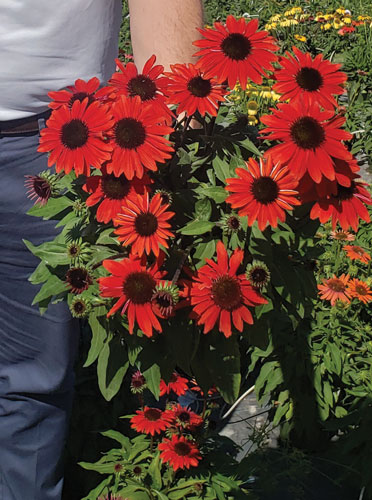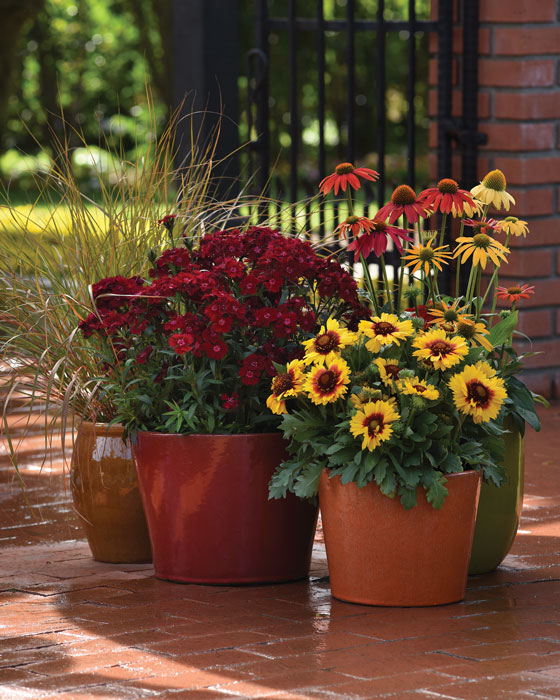4/1/2020
Fall Is for Perennials, Too
Chris Fifo

Fall is probably my favorite season. The transition to the crisp, cool evenings from the hot summer days, the changes in the landscape, and, of course, the changes in the décor to those fall themes of hay bales, pumpkins and mums.
It’s tough to think about fall when we’re in the heat of the spring rush, but this is the time to begin the planning. If you grow fall mums you probably have your inputs ordered already.
Why not add some fresh perennials to the mix as well? Perennials can add a whole new dimension to fall decoration—new colors, new textures, new combinations.
Play up new
Did you catch that keyword “new”? Great word for the garden center. Many people like new. However, there are those who are creatures of habit (like me) and will always gravitate towards what they know—mums (not me).
Pictured: Echinacea Sombrero Salsa Red on October 1 grown outside on drippers.
This is the challenge for fall perennials—they’re generally up against mums and people’s habits. A mum’s instant blast of color can be set anywhere to brighten up a space. Because of this, we need to plan our fall perennial program carefully if we want it to be successful.
First of all, why not put a big “NEW” sign over perennials in the fall garden center? Any particular echinacea, let’s say, may not be new, but we can market these as a “new” way to use them. If we’re going to bring these into the garden center we’re going to have to draw attention to them. Even something as simple as a colored, drop-in pot can bring added interest over a black pot.
So what would be the best way to draw attention to perennials in the fall garden center? Let them speak for themselves! Perennials can be a blast of color all their own. To do this, most perennials will have to be grown fresh and not look like cut back and re-grown leftovers from spring that customers may expect to be on the discount rack.
Not only can we add a blast of color with say, echinacea or asters, but we can also add some texture with items like heuchera and eupatorium. Or how about adding scents with lavender or nepeta?
Play up value
Not only do we need to draw the customers to our perennials in the fall garden center with our blast of color and scent, we need to educate them as to why perennials will add value to their fall décor. Perennials are a good value because they’ll often outlast mums with their extended bloom time—usually well past first frost. Though not specifically marketed for gardening, perennials can be planted in the ground when they’re done being used for decoration.
Perennials can be combined either by the supplier or the customer into larger deco pots for a whole new look. Maybe the garden center could have examples of several different combos on display and supply the inputs for the customer to put together their own at home. Fall perennials are a growing trend and now is the time to be getting inputs in the ground or ordered.
 Variety selection
Variety selection
Obviously, varieties that require overwintering are out; this is a first-year flowering (FYF) program only. Only varieties that can stand up to summer production conditions are suitable for this program. Some perennials won’t perform well in the heat and humidity of summer. They’ll melt away, rot or won’t bulk up and produce an attractive finished product.
Be aware of the regionality of some perennials. Items such as gaillardia aren’t suitable for southern programs. Phlox paniculata may not be best for the West Coast. Iberis may not be best for the north. (Wait … did I say iberis? Yes, there’s a summer long-blooming iberis called Summer Snowdrift.)
Pictured: Fall decoration with seed perennials.
And do we want to use a seed or vegetatively propagated perennial? This is often directly related to price point and container size.
The next consideration is scheduling. For the most part, you want your perennials to be retail-ready about the same time mums are hitting the market.
As mentioned before, you want your perennials to be fresh and not tired-looking. One trim or cutback on some items isn’t necessarily a bad thing. It will encourage more branching and stronger flowering, but something cut back since spring that’s root-bound isn’t the goal. Accurate scheduling is a must.
To do this, consult your resources. Extensive information is available on the Darwin Perennials and Kieft Seed websites, like variety selection, scheduling for fall flowering, plants per pot, etc. There’s a lot of information out there. Take advantage of your resources and do your research! (See Table 1.)
One generality to take note of is that the long-day obligate varieties, such as echinacea and eupatorium, must be planted relatively early in the summer to take advantage of daylength. As the days get shorter, these crops will take longer to flower. One week later in planting can lead to a two week later finish.
Also, be aware that if you’re growing some seed-raised items for fall, like Echinacea PowWow or Rudbeckia Goldsturm, the plugs you use must be “short day-treated” plugs to perform properly. Check with your supplier.
Summer production of perennials in gallon pots is relatively easy. The highest-quality perennials are generally produced outdoors on drippers with little or no PGRs required. However, if the weather doesn’t behave as normal, problems can arise. Cool temperatures can put you behind schedule or flooding rains can wash nutrients from the media. It’s a judgement call.
Many growers use slow-release fertilizer for summer production. This works very well and is easy, but watch your rate. Controlled release is actually uncontrolled based upon temperature and moisture. Too much of each and you can have too much soft top growth (especially if grown indoors under lower light). Control freaks like myself prefer a low to medium rate of CRF supplemented with liquid feed as necessary.
Keep in mind …
What problems can arise with summer perennial production? I would say root rots would be the primary concern. The tendency in the summer can be to overwater. “When in doubt, flood it out” is a common theme on a hot summer day. This is where a bark media can work very well to provide adequate drainage.
Another concern would be an assortment of leaf spots for which I would recommend preventative sprays when conditions are favorable. There are plenty of products available that are effective and don’t leave an unsightly residue.
(A side note on fungicides: I have unscientifically found that Pagaent Intrinsic fungicide can help some perennials with heat stress. I do recommend the use of this product in summer production. It may even help once crops make it to the garden center. I stress that this is my unscientific experience.)
As you work your way through spring, don’t forget that it’s time to get your fall on! Plan to include some perennials in your fall décor. GT

Chris Fifo is a Product Representative for Darwin Perennials and Kieft Seed.